
The Xyridaceae are a family of flowering plants. This family has been recognized by many taxonomists and is known as the yellow-eyed grass family.

Xyris is a genus of flowering plants, the yelloweyed grasses, in the yellow-eyed-grass family. The genus counts over 250 species, widespread over much of the world, with the center of distribution in the Guianas.

Gahnia is a genus of sedges native to China, Southeast Asia, New Guinea, Australia, New Zealand and a number of Pacific Islands. The common name is due to the toothed margins. It often forms tussocks.

Xyris complanata, known as the feathered yellow-eye is a tufted herb in the Xyridaceae family. It is native to southern China, India, Sri Lanka, Thailand, Cambodia, Laos, Vietnam, Malaysia, Indonesia, the Philippines, New Guinea and Australia. It is also naturalized in Hawaii where it is known as Hawai'i yelloweyed grass. In New South Wales it grows in moist areas, often near swamps or in heathland.
Xyris baldwiniana, common name Baldwin's yelloweyed grass, is a North American species of flowering plant in the yellow-eyed-grass family. It is native to southern Mexico (Chiapas), Central America, and the southeastern and south-central United States.
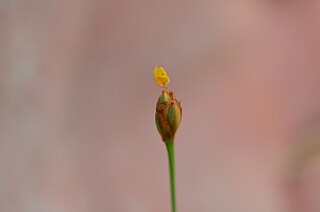
Xyris brevifolia, the shortleaf yelloweyed grass, is a North American species of flowering plant in the yellow-eyed-grass family. It is native to Brazil, the West Indies, and the southeastern United States.
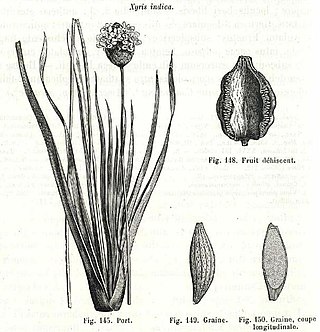
Xyris caroliniana, the Carolina yelloweyed grass, is a North American species of flowering plant in the yellow-eyed-grass family. It is native to Cuba and to the coastal plain of the southern and eastern United States from eastern Texas to New Jersey.
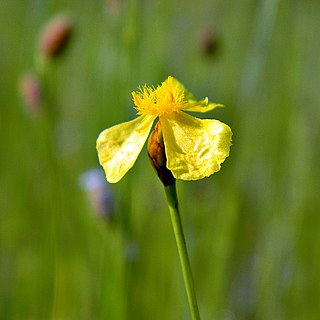
Xyris difformis, the bog yelloweyed grass, is a North American species of flowering plant in the yellow-eyed-grass family. It is native to the eastern and southern United States, eastern and central Canada, and Central America.

Xyris jupicai, common name Richard's yelloweyed grass, is a New World species of flowering plant in the yellow-eyed-grass family. It is widespread in North America, South America, Mesoamerica, and the West Indies.
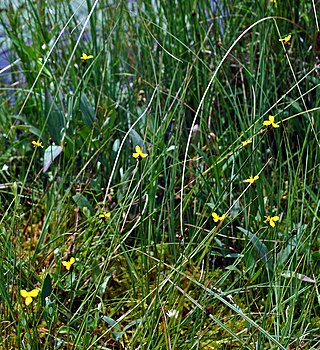
Xyris montana, the northern yelloweyed grass, is a North American species of flowering plants in the yellow-eyed-grass family. It grows in eastern and central Canada and in the northeastern and north-central United States.
Xyris platylepis, the tall yelloweyed grass, is a North American species of flowering plants in the yellow-eyed-grass family. It grows on the coastal plain of the southeastern and south-central United States from eastern Texas to Virginia.

Xyris smalliana, Small's yelloweyed grass, is a North American species of flowering plants in the yellow-eyed-grass family. It grows on the coastal plain of the eastern and southern United States from Maine to Texas, as well as in Cuba, Central America, and the State of Tabasco in southern Mexico.
Xyris stricta, the pineland yelloweyed grass, is a North American species of flowering plants in the yellow-eyed-grass family. It grows on the coastal plain of the southern United States from the Carolinas to Texas.

Xyris torta, the slender yelloweyed grass, is a North American species of flowering plants in the yellow-eyed-grass family. It is widespread in the central and eastern United States from New Hampshire to Georgia, west as far as Minnesota, Nebraska, and eastern Texas.
Barbara Lynette Rye is an Australian botanist born in 1952.

Xyris operculata, the tall yellow-eye, is a flowering plant species endemic to south eastern Australia. Seen in swampy areas, often in heathland. A tufted herb, growing up to 1 metre high. This is one of the many plants first published by Jacques Labillardière, appearing in his Novae Hollandiae Plantarum Specimen in 1805. The specific epithet operculata is derived from Latin. Referring to the hardened tip of the fruiting capsule, which does not divide when the capsule splits, and may be seen being cast aside like a lid.
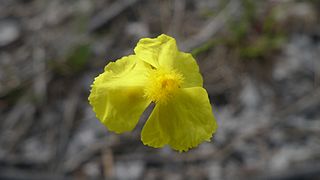
Xyris juncea, the dwarf yellow-eye, is a species of flowering plant found in northern and eastern Australia. It is widespread in swampy areas. It is a tufted herb, growing up to 30 cm high. This is one of the many plants first published by Robert Brown with the type known as "(J.) v.v." Appearing in his Prodromus Florae Novae Hollandiae et Insulae Van Diemen in 1810. The specific epithet juncea is derived from Latin, meaning a resemblance to a sedge.

Xyris bracteata is a yellow-eye which grows in dry or wet heath, or in open eucalyptus woodland with a heath understorey. Only found in eastern New South Wales, Australia, it is a robust erect herb, growing up to 60 cm high. This is one of the many plants first published by Robert Brown, with the type known as "(J.) v.v.", appearing in his Prodromus Florae Novae Hollandiae et Insulae Van Diemen in 1810. The specific epithet bracteata is derived from Latin, meaning "having bracts."

Xyris marginata, commonly known as alpine yellow eye, is a monocot in the family Xyridaceae which is endemic to King Island (Tasmania) and Tasmania, commonly growing in button grass moorlands, at altitudes of up to 1070 meters (3,510.5 ft) above sea level. It was first collected by German-Australian botanist Ferdinand von Mueller in 1875.
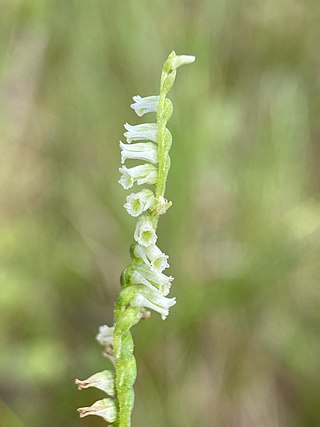
Spiranthes eatonii, commonly known as Eaton's ladies' tresses is a terrestrial orchid endemic to the United States, closely related to or a variation of Spiranthes lacera.














